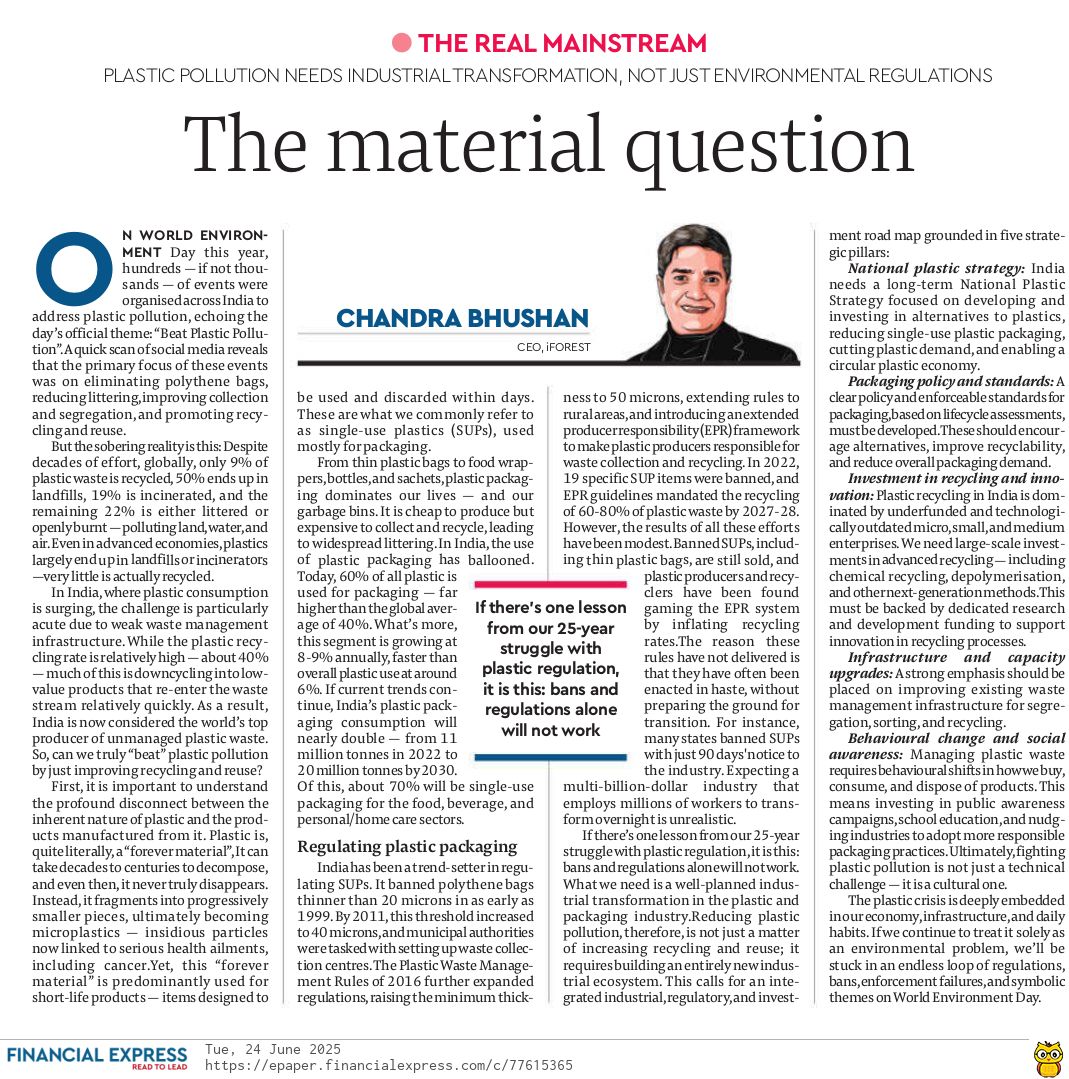This article appeared in Financial Express
Plastic pollution needs industrial transformation, not just environmental regulations.
On World Environment Day this year, hundreds — if not thousands — of events were organised across India to address plastic pollution, echoing the day’s official theme: “Beat Plastic Pollution”. A quick scan of social media reveals that the primary focus of these events was on eliminating polythene bags, reducing littering, improving collection and segregation, and promoting recycling and reuse.
But the sobering reality is this: Despite decades of effort, globally, only 9% of plastic waste is recycled, 50% ends up in landfills, 19% is incinerated, and the remaining 22% is either littered or openly burnt — polluting land, water, and air. Even in advanced economies, plastics largely end up in landfills or incinerators —very little is actually recycled.
In India, where plastic consumption is surging, the challenge is particularly acute due to weak waste management infrastructure. While the plastic recycling rate is relatively high — about 40% — much of this is downcycling into low-value products that re-enter the waste stream relatively quickly. As a result, India is now considered the world’s top producer of unmanaged plastic waste. So, can we truly “beat” plastic pollution by just improving recycling and reuse?

First, it is important to understand the profound disconnect between the inherent nature of plastic and the products manufactured from it. Plastic is, quite literally, a “forever material”, It can take decades to centuries to decompose, and even then, it never truly disappears. Instead, it fragments into progressively smaller pieces, ultimately becoming microplastics — insidious particles now linked to serious health ailments, including cancer.Yet, this “forever material” is predominantly used for short-life products — items designed to be used and discarded within days. These are what we commonly refer to as single-use plastics (SUPs), used mostly for packaging.
From thin plastic bags to food wrappers, bottles, and sachets, plastic packaging dominates our lives — and our garbage bins. It is cheap to produce but expensive to collect and recycle, leading to widespread littering. In India, the use of plastic packaging has ballooned. Today, 60% of all plastic is used for packaging — far higher than the global average of 40%. What’s more, this segment is growing at 8-9% annually, faster than overall plastic use at around 6%. If current trends continue, India’s plastic packaging consumption will nearly double — from 11 million tonnes in 2022 to 20 million tonnes by 2030. Of this, about 70% will be single-use packaging for the food, beverage, and personal/home care sectors.
Regulating plastic packaging
India has been a trend-setter in regulating SUPs. It banned polythene bags thinner than 20 microns in as early as 1999. By 2011, this threshold increased to 40 microns, and municipal authorities were tasked with setting up waste collection centres. The Plastic Waste Management Rules of 2016 further expanded regulations, raising the minimum thickness to 50 microns, extending rules to rural areas, and introducing an extended producer responsibility (EPR) framework to make plastic producers responsible for waste collection and recycling. In 2022, 19 specific SUP items were banned, and EPR guidelines mandated the recycling of 60-80% of plastic waste by 2027-28. However, the results of all these efforts have been modest. Banned SUPs, including thin plastic bags, are still sold, and plastic producers and recyclers have been found gaming the EPR system by inflating recycling rates.The reason these rules have not delivered is that they have often been enacted in haste, without preparing the ground for transition. For instance, many states banned SUPs with just 90 days’ notice to the industry. Expecting a multi-billion-dollar industry that employs millions of workers to transform overnight is unrealistic.
If there’s one lesson from our 25-year struggle with plastic regulation, it is this: bans and regulations alone will not work. What we need is a well-planned industrial transformation in the plastic and packaging industry.Reducing plastic pollution, therefore, is not just a matter of increasing recycling and reuse; it requires building an entirely new industrial ecosystem. This calls for an integrated industrial, regulatory, and investment road map grounded in five strategic pillars
National plastic strategy: India needs a long-term National Plastic Strategy focused on developing and investing in alternatives to plastics, reducing single-use plastic packaging, cutting plastic demand, and enabling a circular plastic economy.
Packaging policy and standards: A clear policy and enforceable standards for packaging, based on lifecycle assessments, must be developed. These should encourage alternatives, improve recyclability, and reduce overall packaging demand.
Investment in recycling and innovation: Plastic recycling in India is dominated by underfunded and technologically outdated micro, small, and medium enterprises. We need large-scale investments in advanced recycling — including chemical recycling, depolymerisation, and other next-generation methods. This must be backed by dedicated research and development funding to support innovation in recycling processes.
Infrastructure and capacity upgrades: A strong emphasis should be placed on improving existing waste management infrastructure for segregation, sorting, and recycling.
Behavioural change and social awareness: Managing plastic waste requires behavioural shifts in how we buy, consume, and dispose of products. This means investing in public awareness campaigns, school education, and nudging industries to adopt more responsible packaging practices. Ultimately, fighting plastic pollution is not just a technical challenge — it is a cultural one.
The plastic crisis is deeply embedded in our economy, infrastructure, and daily habits. If we continue to treat it solely as an environmental problem, we’ll be stuck in an endless loop of regulations, bans, enforcement failures, and symbolic themes on World Environment Day.
Chandra Bhushan is one of India’s foremost public policy experts and the founder-CEO of International Forum for Environment, Sustainability & Technology (iFOREST).
